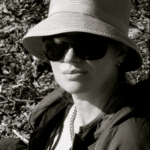Question about starting
-
11 years ago LINK
jodskiinca @jodskiinca
Hi, I just bought this pattern and I haven’t even started because I’m stuck already. LOL.
Ok, under Fabric and Cutting Layouts, in the directions, it says:
Step 1. Fold the fabric right sides together for double thickness. The fabric should be right side up for single thickness.
So, are they basically giving us the option of making the whole dress in a double thickness (like if I used a lightweight linen) or single thickness? I’m thinking the medium weight linen would be single, unless I line it with another fabric, which would be cute, too. I’m going to do a practice run with some lightweight denim I have in my stash. I want to make one with a medium weight linen for a friend. I’m newish to sewing, which is why I need to practice. 🙂 Help!
Jodi
11 years ago LINK Tamara
@justsewit
Tamara
@justsewit
Hi Jodi,
I am guessing you are new to sewing? When you fold the fabric to be a double thickness (as per the pattern) it mean that you fold the fabric so that the selvage on one side meets up with the selvage on the other side of the width of fabric (essentially you are folding the fabric in half width ways). This will allow you to cut out two pieces of the same pattern piece (a left and a right) at the same time. It will also allow you to place pieces on the fold, for example the front and back bodice pieces.
The thickness itself isn’t changed for construction, it is just a method of effective cutting out in order to gain the most of your fabric.
By the way, in case you might be stuck with this one, place the pattern pieces according to the grain. If you were to fold the fabric in half selvage to selvage then you would place the pattern pieces following the same line as the selvage – so if you were looking down from a bird’s eye view at the fabric and pieces laid out they would look side ways.
I do hope this makes sense and sing out if you need any more help. We here are only to happy to oblige.
Tamara
11 years ago LINKjodskiinca @jodskiinca
Hi Tamara,
Maybe I should have explained my question better. I do understand how to make 2 pattern pieces by folding it in half, so that’s what this step is referring to? I was thinking that it was giving the option of making the entire dress in a double thickness, since it said, “Fold the fabric right sides together for double thickness. The fabric should be right side up for single thickness.” I am new to sewing (clearly!) and have always only cut the fabric pieces while the fabric is folded in half, so I guess that confused me. I didn’t realize anyone would cut a single thickness and then cut another single thickness, instead of simply folding it in half and only having to cut once. I hope I’m making sense! Thank you so much for your help!
11 years ago LINK Tamara
@justsewit
Tamara
@justsewit
Oh I am so sorry! Must have skimmed your message and not answered correctly. You could make it in double thickness I guess. I would call it lining. That is easy to do – cut two of each piece, so two fronts, backs left fronts etc. yes I am pretty sure it will work.
Sorry for the confusion (seem to be having alot of that just lately).
11 years ago LINKjodskiinca @jodskiinca
Oh, don’t apologize. You’ve been very helpful. I was just thinking that the pattern was suggesting that we could either do it in a double thickness or single. I understand now, though. Thanks!
11 years ago LINK vothgirl
@vothgirl
vothgirl
@vothgirl
The step referring to folding the fabric in half is for cutting out left and right sides or on the fold, like justsewit explained – the pattern assumes you’re making a single-layer garment. Most pattern pieces will have written on them “cut 2” or “cut 1 on fold” etc and those are the pieces you’d lay on top of the double thickness fabric. The part where it says “the fabric should be right side up for single thickness” refers to pattern pieces which have written on them to “cut 1” (for example, a shirt placket, or binding for a neckline – I just cut out an outfit from the Lullaby Layette pattern and the bodysuit pattern has pieces like those I’ve just described). Most pattern pieces will be cut on the double-thickness fabric, the instructions you read are just explaining which way up the fabric’s face should be for pattern pieces that you only need one of.
I hope that makes sense, I can see why you’d be a bit confused at first! But if you’re new to sewing, you have chosen some wonderful patterns to get you started – you will be amazed at how much you learn and how much better/more skillful of a sewist you will be when you finish an Oliver + S pattern! Good luck, and let us know how it turns out! We’re here to help and we LOVE seeing pictures of your finished creations :-).
11 years ago LINK Nicole
@motherof5
Nicole
@motherof5
Sounds like you are sorted now Jodi, but if you want a peep at the construction, I have a step by step tute here http://www.pinterest.com/pin/73676143878386828/
11 years ago LINK Tamara
@justsewit
Tamara
@justsewit
Just my other two cents here and to help you also differentiate with the double single layer factor, it is wise if you want to match the pattern of the fabric to use the single layer of fabric to cut your pieces out with – say for instance you have a really special print you are using this method would be ideal that way it will look “seamless” when they are meeting on the finished garment.
Just a little tip to help you on your way and I really hope it hasn’t confused you even further.
Good luck! Will you show us when its done?
11 years ago LINKjodskiinca @jodskiinca
I thought I responded to this, but I don’t see it now. I wanted to thank you all for your help! I will be starting the pattern this weekend (hopefully!).
justsewit- I think I understand what you’re saying. Are you saying to lay all of the pieces together, like how I want it to be when finished and cut the pieces that way? I wish you all were just right here, so you could show me every step, in person. 🙂 Thank you!
11 years ago LINK Nicole
@motherof5
Nicole
@motherof5
I wish I could too!
11 years ago LINK vothgirl
@vothgirl
vothgirl
@vothgirl
Jodi, justsewit is referring to pattern-matching – for instance if you want to match stripes or plaid, or perhaps a repeating animal print like this one that I’m currently sewing up: http://www.hawthornethreads.com/fabric/designer/frances_newcombe/safari_moon/animalia_in_splendor (the zebras repeat every 10 inches or so in horizontal rows). While usually you’d fold your fabric in half by matching the selvedges and lay your “cut 2 of” pattern pieces on top, the best way to get the zebras to line up on the fabric I’m using is to leave the fabric in a single layer right side up. Pin the pattern piece on where the zebras fall in the place you want on the (bodice, in my case) and cut out one. Then mark on the pattern piece where the zebra falls (or whatever other repeating pattern is on your fabric) and flip the pattern piece over so it’s wrong side up (so you’ll end up with a right and a left of that pattern piece rather than two left bodices :P) and arrange it on your fabric so the repeating pattern lines up with the marks you made, pin, and cut your second piece. This is referred to as “fussy cutting” (tho that also includes any cutting where you want a particular part of your fabric pattern to fall in a specific part of the piece you’re cutting out). For most fabrics with small/random prints the extra work of fussy cutting isn’t necessary. But for some like the zebra fabric, the garment will look better if the zebras are in a straight line rather than unevenly staggered ;-).
The other element to what justsewit was suggesting is to watch out for directional prints (I’ll use the zebra fabric again as an example): make sure you position your pattern pieces so all the zebras end up right side up rather than hanging upside down like they were hanging from their ankles :P. The grain arrows on your pattern pieces will run parallel to the selvedges and for non-directional prints it doesn’t matter whether the arrow points the same direction (all left or all right) on all your pattern pieces as long as they’re parallel to the selvedges, and sometimes turning/rotating them around helps make the best use of your fabric (like a fun puzzle!). But directional prints require a bit more care. My aunt made me an apron once out of a cute coffee cup print, but didn’t pay attention to the direction the mugs were facing – as a result, all the mugs on my apron are upside down like you’re pouring all the coffee out of them! 😉 (I still love the apron tho!).
I hope that helps rather than further confuse. If you’re in the US and have further questions, I’d be happy to email you my phone number so we could chat. Sometimes these things are best figured out with the instant feedback of a verbal conversation :-).
Best of luck and happy sewing!
11 years ago LINK Tamara
@justsewit
Tamara
@justsewit
Thanks Patricia for interpreting! You hit the nail on the head.
11 years ago LINKjodskiinca @jodskiinca
Thank you so much, I think I understand. I’m wondering if I can search and find a tutorial for that method. Something that shows it in pictures. I do think I’m understanding correctly, though and once I try it myself, I’m sure it’ll be easier to understand.
I wish there was a way to post pictures here. I’m having trouble understanding the page that’s after the last 10 piece. The page has 10A on it as well, on one end. One is right side up and one is upside-down, if that makes sense. I’m not sure what that is for and I’m not sure how to cut it. I see the size 5 line (which is what I’m making) and know to cut there, but am not sure where else to cut. If there’s a picture of the cut piece somewhere, will you please let me know? Or if someone can take a pic of the piece cut to a size 5 and email it to me, that’d be much appreciated! My email is jodskiinca@gmail.com or if that doesn’t show up, it’s jodskiinca AT gmail DOT com 🙂
You must be logged in to reply to this topic.
copyright
Unless otherwise credited, all work on this blog is © Liesl + Co., Inc, 2008-2026. You are welcome to link to this blog, but please ask permission before using any text or images.